Air travel in hotel luggage labels
by Joao-Manuel Mimoso
| Hotel owners have always tried to associate their establishments with symbols of modernity. Their logic was that potential customers would thus conclude that the hotel was also equipped with the latest developments in modern comfort (electric lighting, lifts, room telephones, and so on). From the earliest years of the XX century the antics of the first aviators were front page material to all major newspapers in the world and it is only surprising that so few planes found their way into hotel luggage labels.
|
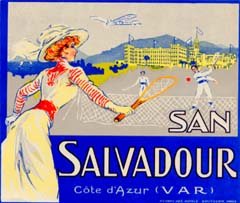 |
| The two fine labels at right, top and side, are amongst the very earliest to depict airplanes. The first, for a French hotel, is a stupendous early label and remarkable in the fact that it is collectable on account of at least three different themes (besides the plane, we have in it a fine representation of period sports clothing and of early tennis playing). The second label is also remarkable on several counts: not only the representation of planes (and indeed any "fancy" theme) is very unusual in the austere designs of early American labels, but also the gothic and comic book-like quality of the building rendition makes this label quite unique. The planes are sufficiently detailed to be recognizable as early Wright glider-equipped biplanes and, seemingly, the hotel sports a launching platform on the roof!
|
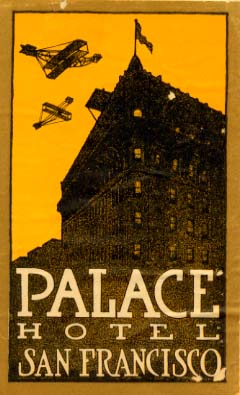 |
| The Zeppelin dirigibles were the first reliable means of long range air travel and were generally considered to be the marvel of their time. Considering their short time span of only ten years, they found their way into a comparatively larger number of labels then the early airplanes. After their demise in 1938, following the Hindenburg destruction in Lakehurst, the depiction of dirigibles was eradicated from labels and it would take another two decades for them to reappear in the nostalgic labels of German hotels named after the popular Graf (Count) Von Zeppelin. The label at right is one of two slightly different designs for the same hotel and probably dates from around 1930. The somber graphics are typical of many German labels of the time. After W.W.II the same hotel would once again use a Zeppelin in its label.
|
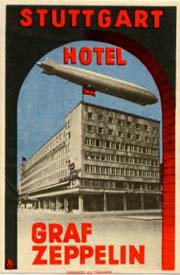 |
| Launched in 1928, the beautifully proportioned Graf Zeppelin was the most successful of all airships. In 1929, the year of the Ibero-American exhibition, the Graf Zeppelin landed in Seville- tickets were sold at 2 pesetas, for those who wanted a closer view of the mooring of the great ship. The sight so impressed Sevillans, that the airship was pictured in this contemporary label for a local hotel. The label is remarkable on another count: the horse-drawn carriage at right was the typical hotel transportation that awaited customers at the train stations to carry them and their luggage to the hotel. It is rarely shown on labels.
|
 |
| This interesting label (one of two similar designs for the same hotel) shows the Hindenburg over Frankfurt. Launched in 1936, the fateful airship could be distinguished from the Graf by its bulkier shape and rounded lower tail fin. Ominously, it sported swastikas on the tail, following the acquisition, by the German government through Luft Hansa, of enough shares to gain control of the company. So did the Graf Zeppelin from 1936 onwards.
|
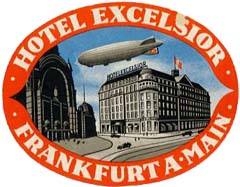 |
| At right, a circa 1953 depiction of a Super Constellation in an otherwise rather boring African label. The most interesting airplane-related labels of the time are for hotels in distant locations that had for clients the passengers of companies that used some local strip and made a night stop before the next hop towards their final destination. The jet age is rarely represented in hotel labels. By then planes, together with cars and many other former signs of modernity, had lost most of their appeal. By then, labels themselves had lost most of their former appeal anyway... given time, what does not? |
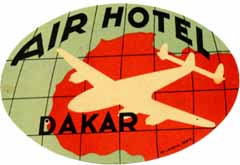 |
Lisbon, Portugal
- uploaded Dec. 27, 2000
- reviewed Nov. 25, 2002
| go to the index of hotel label pages
|